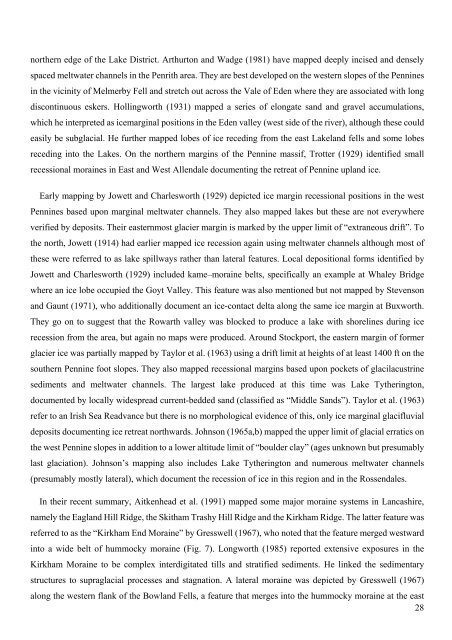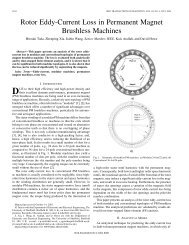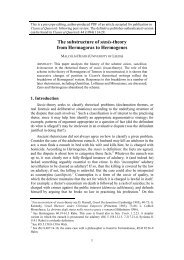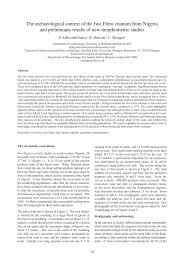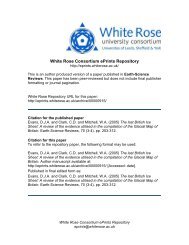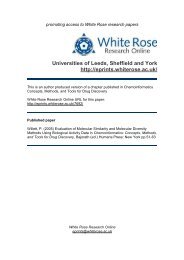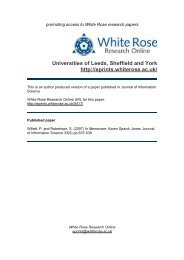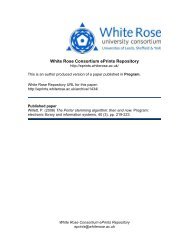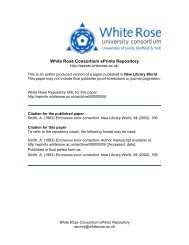The last British Ice Sheet: A review of the evidence utilised in the ...
The last British Ice Sheet: A review of the evidence utilised in the ...
The last British Ice Sheet: A review of the evidence utilised in the ...
You also want an ePaper? Increase the reach of your titles
YUMPU automatically turns print PDFs into web optimized ePapers that Google loves.
nor<strong>the</strong>rn edge <strong>of</strong> <strong>the</strong> Lake District. Arthurton and Wadge (1981) have mapped deeply <strong>in</strong>cised and densely<br />
spaced meltwater channels <strong>in</strong> <strong>the</strong> Penrith area. <strong>The</strong>y are best developed on <strong>the</strong> western slopes <strong>of</strong> <strong>the</strong> Penn<strong>in</strong>es<br />
<strong>in</strong> <strong>the</strong> vic<strong>in</strong>ity <strong>of</strong> Melmerby Fell and stretch out across <strong>the</strong> Vale <strong>of</strong> Eden where <strong>the</strong>y are associated with long<br />
discont<strong>in</strong>uous eskers. Holl<strong>in</strong>gworth (1931) mapped a series <strong>of</strong> elongate sand and gravel accumulations,<br />
which he <strong>in</strong>terpreted as icemarg<strong>in</strong>al positions <strong>in</strong> <strong>the</strong> Eden valley (west side <strong>of</strong> <strong>the</strong> river), although <strong>the</strong>se could<br />
easily be subglacial. He fur<strong>the</strong>r mapped lobes <strong>of</strong> ice reced<strong>in</strong>g from <strong>the</strong> east Lakeland fells and some lobes<br />
reced<strong>in</strong>g <strong>in</strong>to <strong>the</strong> Lakes. On <strong>the</strong> nor<strong>the</strong>rn marg<strong>in</strong>s <strong>of</strong> <strong>the</strong> Penn<strong>in</strong>e massif, Trotter (1929) identified small<br />
recessional mora<strong>in</strong>es <strong>in</strong> East and West Allendale document<strong>in</strong>g <strong>the</strong> retreat <strong>of</strong> Penn<strong>in</strong>e upland ice.<br />
Early mapp<strong>in</strong>g by Jowett and Charlesworth (1929) depicted ice marg<strong>in</strong> recessional positions <strong>in</strong> <strong>the</strong> west<br />
Penn<strong>in</strong>es based upon marg<strong>in</strong>al meltwater channels. <strong>The</strong>y also mapped lakes but <strong>the</strong>se are not everywhere<br />
verified by deposits. <strong>The</strong>ir easternmost glacier marg<strong>in</strong> is marked by <strong>the</strong> upper limit <strong>of</strong> “extraneous drift”. To<br />
<strong>the</strong> north, Jowett (1914) had earlier mapped ice recession aga<strong>in</strong> us<strong>in</strong>g meltwater channels although most <strong>of</strong><br />
<strong>the</strong>se were referred to as lake spillways ra<strong>the</strong>r than lateral features. Local depositional forms identified by<br />
Jowett and Charlesworth (1929) <strong>in</strong>cluded kame–mora<strong>in</strong>e belts, specifically an example at Whaley Bridge<br />
where an ice lobe occupied <strong>the</strong> Goyt Valley. This feature was also mentioned but not mapped by Stevenson<br />
and Gaunt (1971), who additionally document an ice-contact delta along <strong>the</strong> same ice marg<strong>in</strong> at Buxworth.<br />
<strong>The</strong>y go on to suggest that <strong>the</strong> Rowarth valley was blocked to produce a lake with shorel<strong>in</strong>es dur<strong>in</strong>g ice<br />
recession from <strong>the</strong> area, but aga<strong>in</strong> no maps were produced. Around Stockport, <strong>the</strong> eastern marg<strong>in</strong> <strong>of</strong> former<br />
glacier ice was partially mapped by Taylor et al. (1963) us<strong>in</strong>g a drift limit at heights <strong>of</strong> at least 1400 ft on <strong>the</strong><br />
sou<strong>the</strong>rn Penn<strong>in</strong>e foot slopes. <strong>The</strong>y also mapped recessional marg<strong>in</strong>s based upon pockets <strong>of</strong> glacilacustr<strong>in</strong>e<br />
sediments and meltwater channels. <strong>The</strong> largest lake produced at this time was Lake Ty<strong>the</strong>r<strong>in</strong>gton,<br />
documented by locally widespread current-bedded sand (classified as “Middle Sands”). Taylor et al. (1963)<br />
refer to an Irish Sea Readvance but <strong>the</strong>re is no morphological <strong>evidence</strong> <strong>of</strong> this, only ice marg<strong>in</strong>al glacifluvial<br />
deposits document<strong>in</strong>g ice retreat northwards. Johnson (1965a,b) mapped <strong>the</strong> upper limit <strong>of</strong> glacial erratics on<br />
<strong>the</strong> west Penn<strong>in</strong>e slopes <strong>in</strong> addition to a lower altitude limit <strong>of</strong> “boulder clay” (ages unknown but presumably<br />
<strong>last</strong> glaciation). Johnson’s mapp<strong>in</strong>g also <strong>in</strong>cludes Lake Ty<strong>the</strong>r<strong>in</strong>gton and numerous meltwater channels<br />
(presumably mostly lateral), which document <strong>the</strong> recession <strong>of</strong> ice <strong>in</strong> this region and <strong>in</strong> <strong>the</strong> Rossendales.<br />
In <strong>the</strong>ir recent summary, Aitkenhead et al. (1991) mapped some major mora<strong>in</strong>e systems <strong>in</strong> Lancashire,<br />
namely <strong>the</strong> Eagland Hill Ridge, <strong>the</strong> Skitham Trashy Hill Ridge and <strong>the</strong> Kirkham Ridge. <strong>The</strong> latter feature was<br />
referred to as <strong>the</strong> “Kirkham End Mora<strong>in</strong>e” by Gresswell (1967), who noted that <strong>the</strong> feature merged westward<br />
<strong>in</strong>to a wide belt <strong>of</strong> hummocky mora<strong>in</strong>e (Fig. 7). Longworth (1985) reported extensive exposures <strong>in</strong> <strong>the</strong><br />
Kirkham Mora<strong>in</strong>e to be complex <strong>in</strong>terdigitated tills and stratified sediments. He l<strong>in</strong>ked <strong>the</strong> sedimentary<br />
structures to supraglacial processes and stagnation. A lateral mora<strong>in</strong>e was depicted by Gresswell (1967)<br />
along <strong>the</strong> western flank <strong>of</strong> <strong>the</strong> Bowland Fells, a feature that merges <strong>in</strong>to <strong>the</strong> hummocky mora<strong>in</strong>e at <strong>the</strong> east<br />
28


